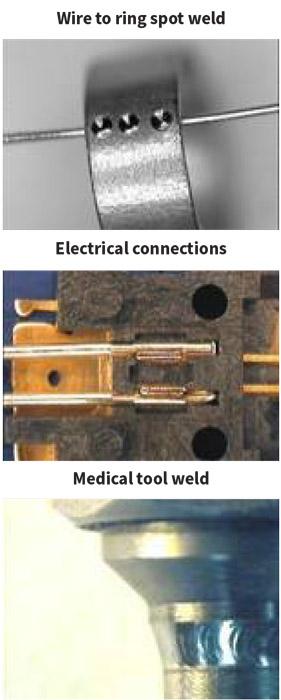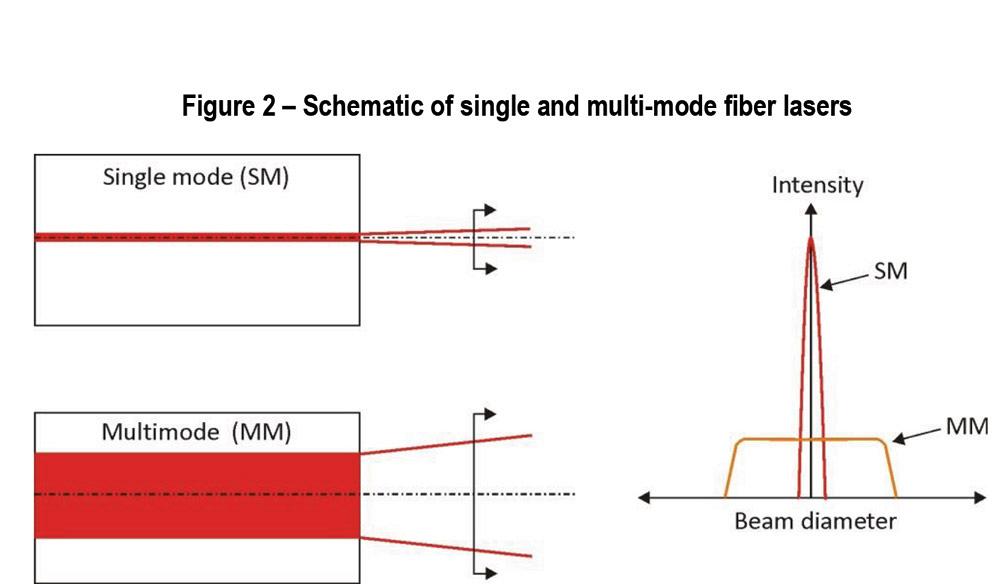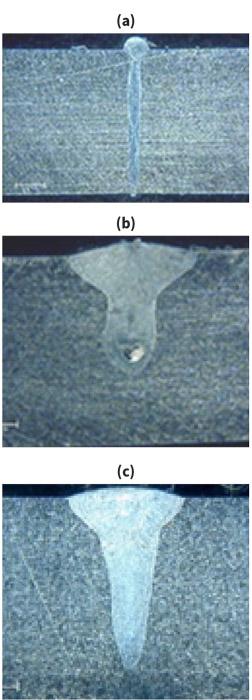Manager, Advanced Technology
- FMA
- The Fabricator
- FABTECH
- Canadian Metalworking
Categories
- Additive Manufacturing
- Aluminum Welding
- Arc Welding
- Assembly and Joining
- Automation and Robotics
- Bending and Forming
- Consumables
- Cutting and Weld Prep
- Electric Vehicles
- En Español
- Finishing
- Hydroforming
- Laser Cutting
- Laser Welding
- Machining
- Manufacturing Software
- Materials Handling
- Metals/Materials
- Oxyfuel Cutting
- Plasma Cutting
- Power Tools
- Punching and Other Holemaking
- Roll Forming
- Safety
- Sawing
- Shearing
- Shop Management
- Testing and Measuring
- Tube and Pipe Fabrication
- Tube and Pipe Production
- Waterjet Cutting
Industry Directory
Webcasts
Podcasts
FAB 40
Advertise
Subscribe
Account Login
Search
Finding the right laser for laser microwelding
How to find the right laser for your application
- By Geoff Shannon
- Updated October 26, 2023
- November 30, 2016
- Article
- Laser Welding

Figure 1
The pulsed Nd:YAG laser is suitable for spot welding applications with less than 0.02-in. penetration and seam welding of heat-sensitive packages.
Four types of lasers can be used for microwelding: pulsed neodymium-doped yttrium aluminum garnet (Nd:YAG), continuous wave (CW) fiber, quasi-continuous wave (QCW) fiber, and nanosecond fiber. Each laser type offers unique features that work best for specific applications. In some cases, several options may work; that’s when cost of ownership and serviceability can tip the scales.
Nd:YAG—Precise Control Laser Microwelding
With the Nd:YAG laser, the active gain medium is neodymium, which is doped into a host crystal of yttrium aluminum garnet. This solid rod of material is typically 0.1 to 0.2 inch in diameter and about 4 in. long. Microwelding Nd:YAG lasers are optically pumped using flashlamps; they typically emit light with a wavelength of 1,064 nm, but can be frequency doubled (532 nm) to appear green.
The laser’s optical design is relatively simple; its heart is the power supply that drives and controls the flashlamp voltage and allows precise control of peak power and pulse width during the laser pulse using internal optical feedback.
With excellent pulse control, the Nd:YAG laser also offers high peak powers in small laser sizes, which enables welding with large optical spot size. This allows optimized part fit-up and laser-to-joint alignment. For example, a 25-watt laser can provide 6 kilowatts of peak power, sufficient to weld steel and aluminum with a 600-micron spot size.
The pulsed Nd:YAG laser has been around for many decades and has by far the largest install base. It is suitable for spot welding applications with less than 0.02-in. penetration and seam welding of heat-sensitive packages (see Figure 1).
Fiber Lasers—Focusability in Micro Laser Welding
A fiber laser is generated within a flexible doped glass fiber that typically is 10 to 30 feet long and 10 to 50 microns in diameter. Ytterbium is used as the doping element because it provides good conversion efficiency and a near 1-micron output wavelength, which matches well with existing laser delivery components.
The laser is generated wholly within a fiber, so there is no need to align the medium to cavity mirrors, nor is it necessary to maintain optics and alignment. The efficient lasing process allows the fiber laser to be small, air-cooled, and offer high wall plug efficiencies.
The fiber laser’s unique characteristics are its focusability and its beam qualities that can be fine-tuned for each welding application. The two ends of the beam quality spectrum are single mode and multimode (see Figure 2). Single mode is defined by a beam quality of M2 less than 1.2, while multimode generally is above M2 of 2.
The mode defines how well the laser can be focused and the power density distribution across the laser. The differences between single-mode and multimode lasers are shown in Figure 3.
Continuous Wave Fiber Lasers. For high-speed seam welding applications, the fiber laser is operated in CW mode. In other words, the laser output remains on until it is turned off. For spot welding either a single weld or a seam, the laser output can be pulsed or, more correctly, modulated, which means the laser is turned on and off rapidly.
The CW laser’s peak power is the same as its maximum average power, so focused spot sizes generally are less than 100 microns to attain sufficient power density for welding with power levels less than 1 kW. Because of the small optical spot size, lap and fillet weld geometries are preferred. Butt welding is possible if there is good part fit-up or if a seam location vision system is used. An alternative method is to use a scan head that can create motion lateral to the weld direction, known as “wobble,” which can effectively widen the weld to decrease joint-alignment sensitivity.
CW fiber lasers are suitable for general seam welding up to 0.06 in. deep for a 500-W laser, high-speed seam welding of same and dissimilar materials, and producing spot welds less than 100 microns in diameter (see Figure 4).
Quasi-Continuous Wave Fiber Lasers. The QCW fiber laser’s peak power and pulse width characteristics are similar to those of the Nd:YAG laser, though the parameter range is not quite as broad. Similar to CW fiber lasers, the QCW lasers offer single-mode to multimode options with spot sizes from 0.001 to 0.04 in. These lasers also shine in small-spot-size and small-penetration applications, although they do offer fairly comprehensive coverage of many microwelding applications (see Figure 5).
Nanosecond Fiber. The nanosecond fiber laser, while typically used for laser marking applications, can be repurposed for certain welding applications (see Figure 6). It provides multikilowatt peak power, but with pulse widths of 60 to 250 nanoseconds that can be delivered between 20 and 500 kilohertz. This high peak power enables welding of almost any metal, including steel, copper, and aluminum. The very short pulse widths enable very fine control for welding small parts, as well as the ability to weld dissimilar materials.
The Big Picture for Laser Microwelding
While a number of lasers are suitable for microwelding, the CW fiber and nanosecond fiber have distinctive application specialties. Nd:YAG is the established source, with great all-around microwelding capability. CW fiber lasers provide excellent speed and penetration characteristics and the ability to weld conductive and dissimilar materials. QCW fiber lasers offer similar capability to the Nd:YAG laser, with additional small-spot and small-penetration features. And finally, the nanosecond laser provides great control using sub-400-ns pulses for thin materials and fine-spot applications, as well as some dissimilar materials bonding.
CW lasers are turned off and on as needed but can be modulated to provide a pulsed output. Nd:YAG and QCW fiber lasers typically offer 0.2- to 4-kW peak power and 0.1- to 10-ms pulse width (see Figure 7). Nanosecond fiber lasers operate at about 10-kW peak power and 60- to 200-ns pulse widths. Figure 7 shows each laser’s peak power and pulse width.
The most interesting comparison is between the Nd:YAG and the QCW fiber laser, which offer similar welding capabilities: Both have high peak power and millisecond pulse widths for large-diameter (greater than 200 microns) spot and seam welding. The Nd:YAG laser has a massive install base and end user familiarity, while the QCW laser is the relative newcomer with some strong cost-of-ownership features. From a welding perspective, they are quite close; from a serviceability standpoint, the QCW laser does not use flashlamps, which reduces maintenance costs, while the Nd:YAG laser is fully serviceable in the field. The choice then can become somewhat of an equipment preference, driven by whether the user requires a laser that is cheaper to run or one that can be maintained 24/7.
About the Author
subscribe now

The Fabricator is North America's leading magazine for the metal forming and fabricating industry. The magazine delivers the news, technical articles, and case histories that enable fabricators to do their jobs more efficiently. The Fabricator has served the industry since 1970.
start your free subscription- Stay connected from anywhere

Easily access valuable industry resources now with full access to the digital edition of The Fabricator.

Easily access valuable industry resources now with full access to the digital edition of The Welder.

Easily access valuable industry resources now with full access to the digital edition of The Tube and Pipe Journal.
- Podcasting
- Podcast:
- The Fabricator Podcast
- Published:
- 04/16/2024
- Running Time:
- 63:29
In this episode of The Fabricator Podcast, Caleb Chamberlain, co-founder and CEO of OSH Cut, discusses his company’s...
- Industry Events
16th Annual Safety Conference
- April 30 - May 1, 2024
- Elgin,
Pipe and Tube Conference
- May 21 - 22, 2024
- Omaha, NE
World-Class Roll Forming Workshop
- June 5 - 6, 2024
- Louisville, KY
Advanced Laser Application Workshop
- June 25 - 27, 2024
- Novi, MI

































